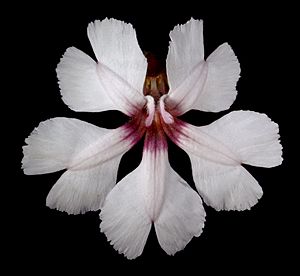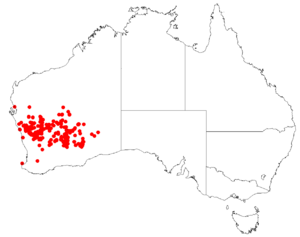Pink velleia facts for kids
Quick facts for kids Pink velleia |
|
|---|---|
 |
|
| Velleia rosea | |
| Scientific classification | |
| Genus: |
Velleia
|
| Species: |
rosea
|
 |
|
| Occurrence data from AVH | |
| Synonyms | |
|
|
The pink velleia, known scientifically as Velleia rosea, is a beautiful plant found only in Western Australia. It belongs to a plant family called Goodeniaceae. This plant blooms with lovely pink flowers from April to October each year.
Contents
What is the Pink Velleia?
The pink velleia is a type of plant called an annual herb. This means it lives for only one growing season. Its leaves are flat and measure about 35 to 70 millimeters (1.4 to 2.8 inches) long. They are also 7 to 15 millimeters (0.3 to 0.6 inches) wide. The edges of the leaves can be toothed or lobed.
Its Flowers and Parts
The flowers of the pink velleia grow on smooth stems called pedicels. These stems are about 5 to 22 millimeters (0.2 to 0.9 inches) long. Each flower has a green outer layer called a calyx, which is about 5 to 7 millimeters (0.2 to 0.3 inches) long. The calyx has small, sticky hairs.
The main part of the flower, called the corolla, is pink. It measures about 10 to 19 millimeters (0.4 to 0.7 inches) long. The outside of the corolla has a few hairs, but the inside is smooth. Inside the flower, the pollen-producing parts (anthers) are separate. The part that holds the seeds (ovary) is at the top of the flower and contains many tiny potential seeds.
Where Does it Grow?
The pink velleia prefers to grow in certain types of soil. You can usually find it in sandy soils or loamy soils. Loamy soil is a mix of sand, silt, and clay, which is often very good for plants.
Pink Velleia's Location
This plant is found in many different areas across Western Australia. These areas are part of special regions known as IBRA regions, which stand for Interim Biogeographic Regionalisation for Australia. The pink velleia lives in regions like Yalgoo and Murchison. It also grows in the Great Victoria Desert and Coolgardie. Other places include Carnarvon, Gascoyne, and the Nullarbor. You can also spot it in the Geraldton Sandplains and the Avon Wheatbelt.

